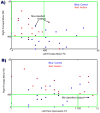Multimodal neuroimaging based classification of autism spectrum disorder using anatomical, neurochemical, and white matter correlates
- PMID: 25797658
- PMCID: PMC4782775
- DOI: 10.1016/j.cortex.2015.02.008
Multimodal neuroimaging based classification of autism spectrum disorder using anatomical, neurochemical, and white matter correlates
Abstract
Neuroimaging techniques, such as fMRI, structural MRI, diffusion tensor imaging (DTI), and proton magnetic resonance spectroscopy (1H-MRS) have uncovered evidence for widespread functional and anatomical brain abnormalities in autism spectrum disorder (ASD) suggesting it to be a system-wide neural systems disorder. Nevertheless, most previous studies have focused on examining one index of neuropathology through a single neuroimaging modality, and seldom using multiple modalities to examine the same cohort of individuals. The current study aims to bring together multiple brain imaging modalities (structural MRI, DTI, and 1H-MRS) to investigate the neural architecture in the same set of individuals (19 high-functioning adults with ASD and 18 typically developing (TD) peers). Morphometry analysis revealed increased cortical thickness in ASD participants, relative to typical controls, across the left cingulate, left pars opercularis of the inferior frontal gyrus, left inferior temporal cortex, and right precuneus, and reduced cortical thickness in right cuneus and right precentral gyrus. ASD adults also had reduced fractional anisotropy (FA) and increased radial diffusivity (RD) for two clusters on the forceps minor of the corpus callosum, revealed by DTI analyses. 1H-MRS results showed a reduction in the N-acetylaspartate/Creatine ratio in dorsal anterior cingulate cortex (dACC) in ASD participants. A decision tree classification analysis across the three modalities resulted in classification accuracy of 91.9% with FA, RD, and cortical thickness as key predictors. Examining the same cohort of adults with ASD and their TD peers, this study found alterations in cortical thickness, white matter (WM) connectivity, and neurochemical concentration in ASD. These findings underscore the potential for multimodal imaging to better inform on the neural characteristics most relevant to the disorder.
Keywords: Autism; Classification; DTI; MRI; Multimodal neuroimaging; Spectroscopy.
Copyright © 2015 Elsevier Ltd. All rights reserved.
Figures






Similar articles
-
Altered white matter integrity in adults with autism spectrum disorder and an IQ >100: a diffusion tensor imaging study.Acta Psychiatr Scand. 2017 Jun;135(6):573-583. doi: 10.1111/acps.12731. Epub 2017 Apr 13. Acta Psychiatr Scand. 2017. PMID: 28407202
-
A combined diffusion tensor imaging and magnetic resonance spectroscopy study of patients with schizophrenia.Schizophr Res. 2016 Feb;170(2-3):341-50. doi: 10.1016/j.schres.2015.12.003. Epub 2015 Dec 21. Schizophr Res. 2016. PMID: 26718333 Free PMC article.
-
Association of White Matter Structure With Autism Spectrum Disorder and Attention-Deficit/Hyperactivity Disorder.JAMA Psychiatry. 2017 Nov 1;74(11):1120-1128. doi: 10.1001/jamapsychiatry.2017.2573. JAMA Psychiatry. 2017. PMID: 28877317 Free PMC article.
-
Altered white matter connectivity as a neural substrate for social impairment in Autism Spectrum Disorder.Cortex. 2015 Jan;62:158-81. doi: 10.1016/j.cortex.2014.10.014. Epub 2014 Nov 5. Cortex. 2015. PMID: 25433958 Review.
-
[Structural and functional neuroanatomy of attention-deficit hyperactivity disorder (ADHD)].Encephale. 2009 Apr;35(2):107-14. doi: 10.1016/j.encep.2008.01.005. Epub 2008 Jul 7. Encephale. 2009. PMID: 19393378 Review. French.
Cited by
-
Abnormalities of Gray Matter Volume and Its Correlation with Clinical Symptoms in Adolescents with High-Functioning Autism Spectrum Disorder.Neuropsychiatr Dis Treat. 2022 Apr 1;18:717-730. doi: 10.2147/NDT.S349247. eCollection 2022. Neuropsychiatr Dis Treat. 2022. PMID: 35401002 Free PMC article.
-
Autism Spectrum Disorder: From Experimental Models to Probiotic Application with a Special Focus on Lactiplantibacillus plantarum.Nutrients. 2025 Jul 29;17(15):2470. doi: 10.3390/nu17152470. Nutrients. 2025. PMID: 40806055 Free PMC article. Review.
-
FMRI hemodynamic response function (HRF) as a novel marker of brain function: applications for understanding obsessive-compulsive disorder pathology and treatment response.Brain Imaging Behav. 2021 Jun;15(3):1622-1640. doi: 10.1007/s11682-020-00358-8. Brain Imaging Behav. 2021. PMID: 32761566 Free PMC article.
-
Autism Spectrum Disorder Detection by Hybrid Convolutional Recurrent Neural Networks from Structural and Resting State Functional MRI Images.Autism Res Treat. 2023 Dec 20;2023:4136087. doi: 10.1155/2023/4136087. eCollection 2023. Autism Res Treat. 2023. PMID: 38152612 Free PMC article.
-
Machine-learning classification using neuroimaging data in schizophrenia, autism, ultra-high risk and first-episode psychosis.Transl Psychiatry. 2020 Aug 17;10(1):278. doi: 10.1038/s41398-020-00965-5. Transl Psychiatry. 2020. PMID: 32801298 Free PMC article.
References
-
- Adolphs R. The neurobiology of social cognition. Current Opinion in Neurobiology. 2001;11(2):231–239. - PubMed
-
- Adolphs R. The social brain: neural basis of social knowledge. Annual Review of Psychology. 2009;60:693–716. http://dx.doi.org/10.1146/annurev.psych.60.110707.163514. - DOI - PMC - PubMed
-
- Akshoomoff N, Lord C, Lincoln AJ, Courchesne RY, Carper RA, Townsend J, et al. Outcome classification of preschool children with autism spectrum disorders using MRI brain measures. Journal of the American Academy of Child & Adolescent Psychiatry. 2004;43(3):349–357. - PubMed
-
- Alexander AL, Lee JE, Lazar M, Boudos R, DuBray MB, Oakes TR, et al. Diffusion tensor imaging of the corpus callosum in Autism. NeuroImage. 2007;34(1):61–73. - PubMed
-
- Amaral DG, Schumann CM, Nordahl CW. Neuroanatomy of autism. Trends in Neurosciences. 2008;31(3):137–145. - PubMed
Publication types
MeSH terms
Substances
Grants and funding
LinkOut - more resources
Full Text Sources
Other Literature Sources
Medical
Miscellaneous

